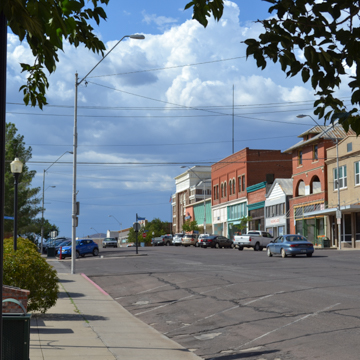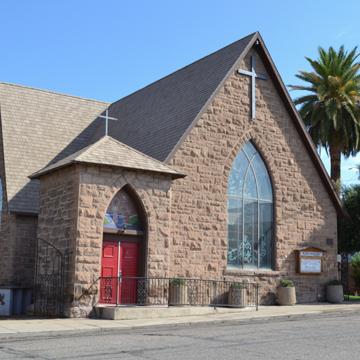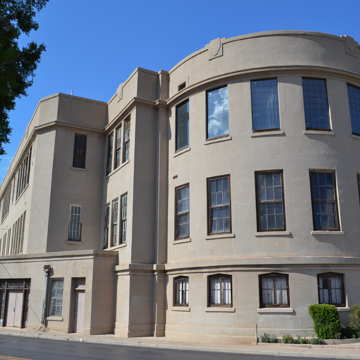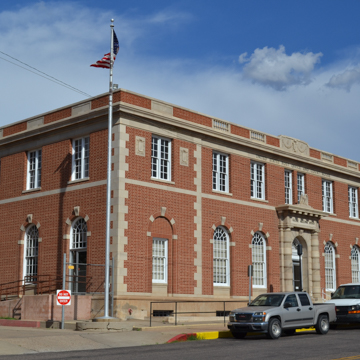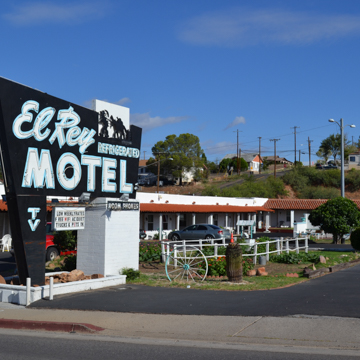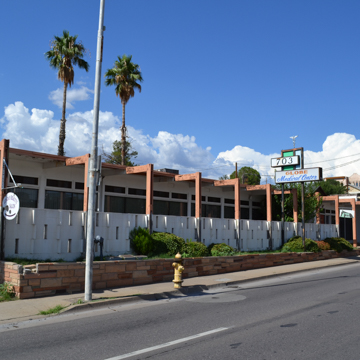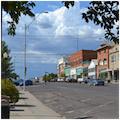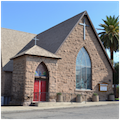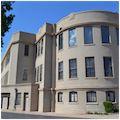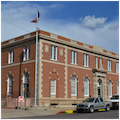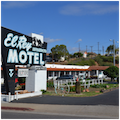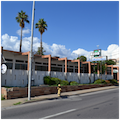The Globe Historic District encompasses the town’s early-twentieth-century business and governmental district, which has retained much of its original appearance and identity. The area developed primarily between 1876 and 1935 as the seat of Gila County and the trading center for one of Arizona’s richest copper mining regions. Reflecting the town’s economic history, the buildings in the district are also representative of the trends and styles of commercial architecture found throughout the American West. Throughout most of the historic period, the primary economic force in Globe was the Old Dominion Copper Mining and Smelting Company, later managed by Phelps Dodge and Company, but this was never a “company town.” Rather, Globe’s downtown developed as an independent commercial center.
The founding and development of Globe is inextricably linked to mining in the region. In September 1873, the “Globe” and the “Globe Ledge” silver claims were filed. In 1875, the Silver King lode was discovered, triggering a rush to the Pinal Mountain Country, as it was then called. Among the excavated ore, it was reported, miners found a large, round boulder of nearly pure silver with deformations resembling earth’s continents. This “globe” (of sizeable proportions and great value) eventually led to the new camp’s name. Although the silver soon played out, the discovery of vast copper deposits in the vicinity helped to create a permanent settlement, leading to the subsequent development of Globe and the neighboring communities of Miami, Claypool, and Inspiration.
In the early summer of 1876, surveyor A.G. Pendleton laid out Globe on a site chosen because of its convenience as a distribution point for the silver mines and its proximity to an adequate water supply from Pinal Creek. By early fall, a colony of miners arrived from Silver City, New Mexico, eager to replicate the success of a previous group that had ventured to Clifton. Globe was soon a thriving mining camp, with a cluster of houses, two stores, and several saloons. The initial canvas tents gave way to adobe structures. Charles M. Shannon and Bob Metcalf (members of the earlier Silver City contingent) erected the first of these, a house later converted into a store. After the establishment of two saw mills in 1878, frame buildings were interspersed with the adobe ones.
Globe, well on its way to becoming a permanent community, was incorporated in 1880 and it became the county seat of Gila County, carved out of Pinal and Maricopa counties. This incorporation lapsed after 1888 and it was not until May 1900 that the Town of Globe was incorporated, with George W.P. Hunt, later the first governor of the state of Arizona, as mayor. After another round of disincorporation, the City of Globe was finally, permanently, incorporated in 1907.
Copper mining commenced in 1878 on the Hoosier claim, which originally had been located for its silver. In 1881, the Old Dominion Copper Mining and Smelting Company of New York erected the first copper smelter. The following year, the company acquired the Globe and Globe Ledge claims from the Old Globe Copper Company. In 1895, the Lewisohn Brothers of New York purchased the Old Dominion Company and proceeded to develop the mine into one of the world’s most important copper producers.
Meanwhile, Dr. James S. Douglas, working on behalf of Phelps Dodge, acquired several mines in the Globe District, including the Hoosier claim. Together these mines became the property of the United Globe Mines. By 1904, a working agreement combined the operations of the United Globe Mining Company and the Old Dominion Copper Mining and Smelting Company under the management of the Phelps Dodge Corporation. The agreement was formalized as a merger in 1917. As a result, and in conjunction with their operations in Morenci, Bisbee and later, Ajo, Phelps Dodge became one of the industrial giants of the twentieth century.
In the 1890s, a few commercial buildings were constructed of brick or stone, but most of the business district was adobe or frame. Frequent floods destroyed or damaged many of these buildings. The earthquake of 1887 and a violent windstorm in 1898 also damaged a number of structures, but fire wreaked the greatest havoc. In June 1894, Globe’s worst disaster occurred when the entire business district between Cedar and Pinal streets burned. In July 1901, another fire demolished twenty-five buildings on Broad Street, north of Bailey Street.
Each of these disasters resulted in the rebuilding of parts of the business district along Broad. Gradually, the street face began to change. Despite the presence of a local brick kiln as early as 1891, a preference for inexpensive adobe and frame persisted. Eventually, however, buildings of locally fired brick and locally quarried stone prevailed. To counteract Globe’s rough-and-tumble mining camp image, residents established institutions of “civilized life,” leading to the construction of buildings for schools, churches, and fraternal organizations. In 1898, the railroad arrived, triggering an influx of new settlers and new goods and materials.
Between 1906 and 1911, the federal construction of Roosevelt Dam, 35 miles to the northwest, directly influenced construction activity in Globe’s commercial district when the U.S. Reclamation Service brought stonemasons from Italy to build the dam’s retaining walls out of sandstone. Many of these stonecutters were subcontracted to work in Globe on civic and commercial structures built of dacite, a dense stone of volcanic origin, or tufa, similar to limestone; both dacite and tufa were quarried locally.
Better connections to the outside world via the railroad and the Reclamation’s Apache Trail service road combined with the construction of Roosevelt Dam and the copper boom of 1904–1906 brought prosperity to Globe. Several new commercial and civic buildings on Broad Street were constructed at this time, including the Gila County Courthouse and the Old Dominion Hotel (demolished). The boom was momentarily interrupted when the international price of copper plummeted during the Wall Street Panic of 1907.
By the spring of 1908 the economy had recovered and the Old Dominion Mining Company was again in full swing. Banks reopened, and the construction boom resumed. The dam construction also led to increased interest in the use of concrete as a building material. In 1908, the Globe Cement and Construction Company plant began manufacturing concrete brick and block. It was during this period that the majority of the district’s current buildings were constructed, including the Gila Valley Bank and Trust (1909) and the Elks Building (1910). By then, Globe was the state’s fourth largest city, with a population of 7,000. Globe High School was built in 1914; the virtually identical Noftsger Hill School and the East Globe School were completed in 1917. Henry Trost’s Hill Street School was finished in 1918.
The increased stability of the community was evident in the construction of two impressive houses of worship, both built of tufa: St. John’s Episcopal Church (1910) and the Holy Angels Roman Catholic Church (1918). In addition, the Arizona Eastern Railway Company erected three new buildings to accommodate increased freight and passenger traffic. This period also saw the advent of the automobile in Globe as roadway and other infrastructure improvements were made and a number of automobile sales and service buildings were constructed.
After World War I, Globe experienced a series of setbacks, beginning with a 1919 flood that caused extensive property damage. Even more significantly, with the end of the war, copper prices decreased precipitously, causing a local economic depression. The Old Dominion shut down its smelter permanently in 1924. In 1931, the company discontinued all mining operations after exhausting its high-grade ore body. Though later innovations in refining lower-grade ore resulted in the development of new mines in the vicinity, never again did Globe experience an economic boom to rival the heyday of the Old Dominion. Nevertheless, Globe has remained the area’s governmental and commercial center.
There was limited construction during the interwar decades but one of the most impressive buildings from this period was the U.S. Post Office and Courthouse of 1927. A few noteworthy buildings were erected in the community at midcentury, mostly beyond the downtown core. These include the El Rey Motel in 1949; Gila General Hospital by Place and Place of Tucson in 1950; the “new” Valley National Bank in 1952; and the Globe Medical Center by Ralph Haver of Phoenix, and Western Savings, almost certainly by Wyatt and Rhodes of Phoenix, both circa 1966.
Listing in the National Register of Historic Places in 1987 marked a resurgence of community interest in the preservation and rehabilitation of the Globe Downtown Historic District. Today, the Globe Historic District retains a distinctive assemblage of late-nineteenth- and early-twentieth-century commercial, public, and ecclesiastical architecture. These buildings illustrate the evolution of commercial architecture in Arizona from simple adobe structures to the stylistic manifestations of Art Deco. Because the greatest period of building activity was between 1904 and 1920, most building exhibit strong classical overtones.
In 2016, the town entered into a partnership with the Scottsdale-based Frank Lloyd Wright Foundation and School of Architecture at Taliesin West to identify and conceptualize revitalization opportunities within the district and beyond.
References
Haak, Wilbur. Globe’s Historic Buildings. Globe, AZ: Gila County Historical Museum, c. 2000.
Haak, Wilbur A., and Lynn F. Globe.Mt. Pleasant, SC: Arcadia Books, 2008.
Vinson, Mark, et al. And TiKo-Tu? The Midcentury Architecture of Metro Phoenix’ East Valley.Phoenix: Rio Salado Architecture Foundation, 2016.
Weisiger, Marsha, “Globe Commercial and Civic Multiple Resource Area,” Gila County, Arizona. National Register of Historic Places Inventory Nomination Form, 1987. National Park Service, U.S. Department of the Interior, Washington, D.C.

















